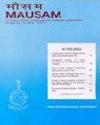Drought analysis in southern region of Tamil Nadu using meteorological and remote sensing indices
IF 0.7
4区 地球科学
Q4 METEOROLOGY & ATMOSPHERIC SCIENCES
引用次数: 0
Abstract
Drought is a natural phenomenon caused due to inadequate rainfall over a region as compared to the expected amount, which when sustained over an extended period of time, eventually leads to shortage of water to sustain various human activities. One-month SPI showed that the southern zone is highly prone to moderate drought conditions. The seasonal analysis of SPI showed that the region faced more drought instances during the South West Monsoon compared with North East Monsoon season. Thoothukudi, Dindigul, Pudukkottai and Virudhunagar showed the high occurrences of drought at seasonal and annual scale. The weekly MAI calculated indicated a risk in the rainfed cropping season. Tirunelveli and Tenkasi showed highly vulnerable to moderate drought. NDVI during the NEM 2016, 2017 and 2018 showed that more than 80 per cent of the total area in the southern districts was under drought stress. NDVI analysis showed that Thoothukudi, Ramanathapuram, Pudukkottai, Sivagangai and Virudhunagar districts are highly vulnerable to drought. NDWI analysis during the NEM 2016, 2017 and 2018 showed high drought stresses with more than 90 per cent of the area showing drought stress during these three years. NDVI and NDWI analysis showed that the Southern Zone of Tamil Nadu was most vulnerable to Moderate and Severe droughts. The comparison of NDVI and NDWI and 3-, 6-, 9- and 12-month SPI showed that the three indices are fairly accurate with each other and hence are useful in the analysis of drought. However, just a single drought index cannot clearly define accurately the spatial and temporal extent of drought. Thus, a combination of meteorological and remote sensing indices gave a detailed idea about the spatio-temporal extent of drought.利用气象和遥感指数分析泰米尔纳德邦南部地区的干旱
干旱是一种自然现象,是由于一个地区的降雨量低于预期而引起的,这种情况持续很长一段时间后,最终会导致维持各种人类活动所需的水资源短缺。一个月SPI显示,南部地区非常容易出现中度干旱。SPI的季节分析表明,西南季风季节与东北季风季节相比,该地区面临更多的干旱事件。Thoothukudi、Dindigul、Pudukkottai和Virudhunagar在季节和年尺度上都表现出较高的干旱发生率。每周的MAI计算表明在雨养作物季节存在风险。Tirunelveli和Tenkasi对中度干旱表现出高度脆弱性。2016年、2017年和2018年新千年期间的NDVI显示,南部地区80%以上的总面积处于干旱压力之下。NDVI分析显示,Thoothukudi、Ramanathapuram、Pudukkottai、Sivagangai和Virudhunagar地区极易受到干旱的影响。2016年、2017年和2018年新千年期间的NDWI分析显示,这三年中,超过90%的地区出现了干旱压力。NDVI和NDWI分析表明,泰米尔纳德邦南部地区最容易发生中、重度干旱。NDVI和NDWI与3、6、9、12个月SPI的比较表明,这3个指数具有较高的准确性,可用于干旱分析。然而,单一的干旱指数并不能清晰准确地界定干旱的时空程度。因此,将气象和遥感指标结合起来,可以更详细地了解干旱的时空程度。
本文章由计算机程序翻译,如有差异,请以英文原文为准。
求助全文
约1分钟内获得全文
求助全文
来源期刊

MAUSAM
地学-气象与大气科学
CiteScore
1.20
自引率
0.00%
发文量
1298
审稿时长
6-12 weeks
期刊介绍:
MAUSAM (Formerly Indian Journal of Meteorology, Hydrology & Geophysics), established in January 1950, is the quarterly research
journal brought out by the India Meteorological Department (IMD). MAUSAM is a medium for publication of original scientific
research work. MAUSAM is a premier scientific research journal published in this part of the world in the fields of Meteorology,
Hydrology & Geophysics. The four issues appear in January, April, July & October.
 求助内容:
求助内容: 应助结果提醒方式:
应助结果提醒方式:


